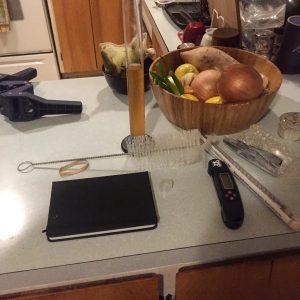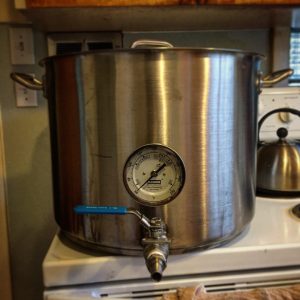
I just bottled my first ever batch of beer. I’m glad a used such a simple recipe to begin with; it helped me gain an understanding of the process with little stress. I now have a strong understanding of the brewing process through lectures, books, and conversations with brewers. This baseline batch was necessary to asses my problems and move forward with more complicated recipes.
The starting gravity was 1.053 and final gravity was 1.027
The first measurement was taken with a hydrometer, and the second with a refractometer. The first reading would also have been taken with a refractometer if I had one at the time.
To find the ABV of the beer I used the formula: ABV=(OG-FG)131.25 (1.053-1.027)131.25=3.41%
This is a very weak percentage for what it should have been, upper 6%. I attribute this to fermentation temperatures constantly fluctuating. For this batch I tried to keep everything sanitized well during transfers, and handled properly. The fermentation temperature was the only thing not executed properly due to lack of equipment. For my next batch I hope to procure a heating pad, and temperature controller.
The Attenuation of a fermentation is the amount of sugars that the yeast consumes measured in percentage. Each yeast has a certain level of attenuation that it should achieve, which is greatly effected by temperature. Yeasts have different temperature ranges that need to stay constant throughout the fermentation for proper attenuation to occur.
Apparent attenuation is measured using the formula: AA=(OG-FG)/(OG-1) (1.053-1.027)/(1.053-1) =0.49 or 49%
The yeast I used did not give the approximate attenuation rate, however it was an American strain, and should have a relatively high attenuation rate. The apparent
attenuation is not not the actual level of attenuation; it does not account for all sugars still present. Because alcohol is less dense than water, and sugar is more dense it the actual attenuation will be far less. For mine it would probably be around 30 to 35 percent, which is not very good at all. Five ounces of dextrose

(corn sugar) were added in solution before the time of bottling.The addition of this priming sugar at bottling might have improved this level slightly. The priming sugar is added before bottling for a tertiary fermentation in bottle. This releases CO2, which is trapped, and thus naturally adds carbonation over the course of two weeks.
Currently I am working on piecing together my mash bill for my next batch of beer. I was genuinely inspired by the speakers at the Cascadia Grains Conference to use specialty, unorthodox grains in my mash. I am going to work with the owners of the local home-brew shop to develop a more advanced recipe using either home malted, or at least home

roasted grains. I have just purchased a new-to-me brew kettle that is 10 gallons, to support an all grain batch. The new kettle has both a spigot, and a thermometer built in to expedite my next batch. This new kettle can also be used as a hot liquor tank to maintain perfect mash temperatures.